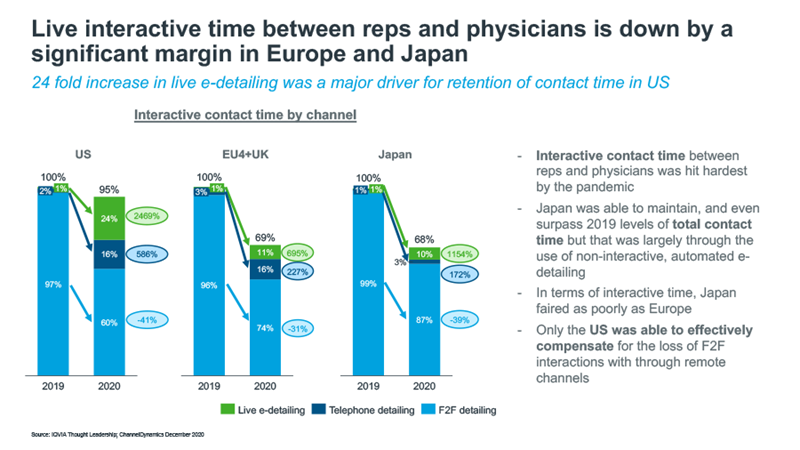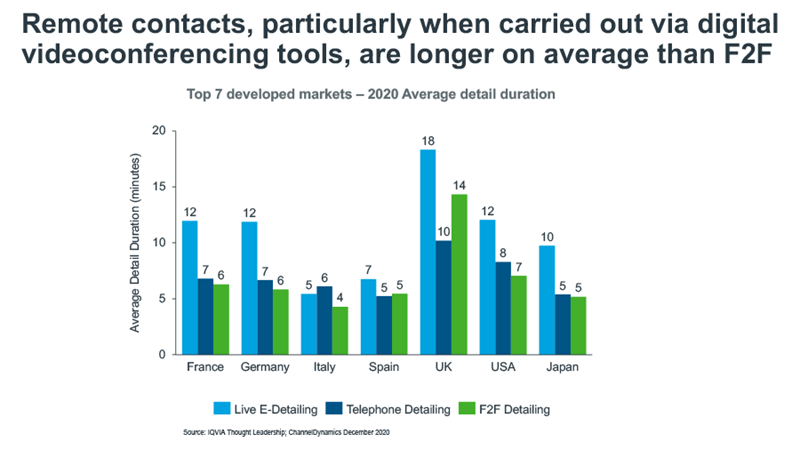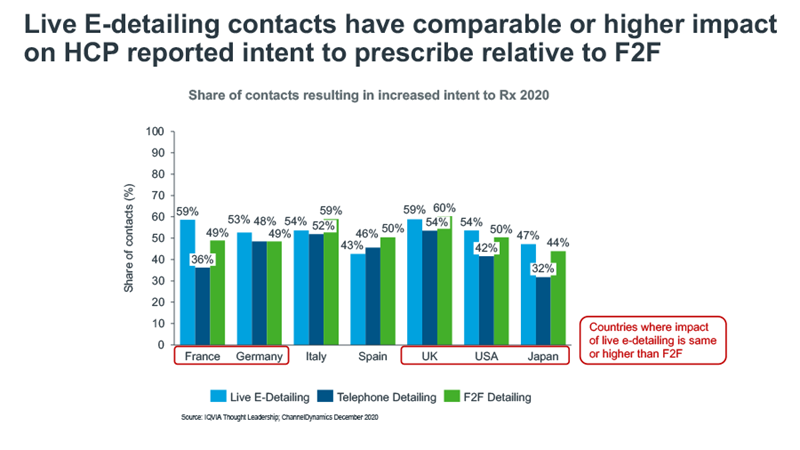





















- Blogs
- Channel Impact: can virtual contacts really pick up the slack?
Prior to 2020, face to face (F2F) detailing was the central pillar of pharma communication with HCPs and, while recent years had seen some movement towards a more orchestrated multichannel approach, remained the main channel for raising awareness and driving uptake of new products. The restrictions on F2F contacts imposed by the COVID-19 pandemic triggered an explosion in the volume of live e-detailing and telephone detailing, as the only alternatives to maintaining interactive contact between reps and physicians. However, adoption of these channels, live e-detailing in particular, had been so low that even the 10 to 20 fold increases in volume use seen in some countries were not sufficient to fully compensate for the time with HCPs lost from F2F (Figure 1). Looking across major geographies (US, Japan, China, EU5), only the US came close to maintaining the previous year's level of interactive contact time. Although Japan was able to maintain, and even surpass 2019 levels of total contact time, that was largely through the use of non-interactive, automated e-detailing (not shown in the chart below). In terms of interactive time, Japan faired as poorly as Europe.

Disruption to F2F contacts is likely to continue well into 2021, as vaccine roll out timelines will dictate easing of social distancing measures, and welcoming reps back into healthcare facilities may not be a priority. Beyond 2021, doctors could have less time to see reps F2F as they seek to address the non-COVID treatment backlog and may simply have lost the habit or gained a preference for remote engagement. Inevitably, remote interactive channels will continue to feature more prominently in the commercial model of the future. In light of this new reality, one big question remains: will this new promotional mix and, more specifically, remote detailing channels, be as effective as the previous F2F-centric model in driving uptake of products? Ultimately, this question will only be answered fully in time, when the immediate infection crisis is passed, and commercial activities settle into the new steady state. Nonetheless, one year on from the onset of the pandemic, IQVIA’s ChannelDynamics® promotional audit data provides some early clues as to the direction of change.
We assessed the performance of the three key interactive detailing channels - F2F, telephone, and live e-detailing (carried out via a virtual conferencing tool such a Zoom, Teams, etc) - based on two indicators of impact:
- Average detail duration - an important indicator as the time a rep spends with an HCP is critical to conveying the necessary information to ensure the HCP is comfortable prescribing the product, as well as to building the relationship and trust between them
- Reported intent to prescribe - the HCPs future intended level of prescribing after the interaction; while this metric is not as robust as tracking actual Rx levels resulting from a particular contact, it serves as a good proxy
When looking at average call duration for 2020 we found that in all of the countries we included in the analysis live e-details were longer on average than F2F details (Figure 2a). One likely reason for this is that e-details are able to be scheduled for a time that is most convenient for the physician meaning they have more time to dedicate to it. What is more, in all countries except Spain, the average duration of a live e-detail increased in 2020 relative to 2019 (Figure 2b). This is likely due to a number of reasons: physicians became more used to them as the whole world embraced virtual communication channels, some physicians not directly involved in treating COVID infections may have had more time due to decreased patient visits, or the fact that live e-details were replacing contacts that would normally being held F2F, rather than being supplementary to F2F contacts.

We also discovered that live e-details matched or outperformed F2F details in terms of impact on intent to prescribe in all countries except Spain and Italy (Figure 3a). This exception is most probably due to the fact that the promotional model in these countries is culturally very traditional and dominated by F2F, far more focused on relationships and high-touch, personal interactions between reps and physicians.

The fact that these remote virtual interactions have the potential to be as impactful, if not more so, than F2F interactions in terms of driving prescriptions is hugely encouraging to the industry. Not only that, but 2020 also saw the impact of live e-details on reported prescribing behaviour increase significantly compared to 2019 (Figure 3b), suggesting that as these types of interaction become more commonplace and companies become better at delivering high quality virtual experiences to their customers, their effectiveness at driving uptake will continue to improve.
The past year has definitively changed HCP behaviours and expectations and, with healthcare systems stretched to the limit as they work to recover from the pandemic, widespread use of digital is here to stay. It is vital that the industry embrace this direction of change and continue to commit to building a new commercial model in which remote, interactive contacts are included as core channels, providing engagement impact that is as effective, or more effective than the model it replaces, and is fit for purpose in the post pandemic environment.





